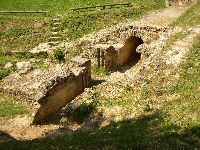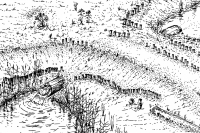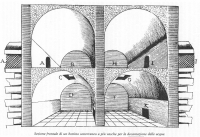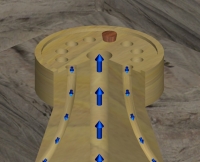



Control
Many aqueduct studies present a static view: the water source, the main conduit with tunnels, bridges, and sometimes a siphon, with at the end a kind of water distribution in the town. But how about seasonal fluctuations in the supply, day and night rythms on the demand side, temporarily shut down of a section for maintenance and repair? Was there any controle in Roman aqueducts?There is nearly no literature about control of aqueducts but we do have some knowledge about control devices based on archaeological evidence. In open channels we discern sluice-gates, swing valves, and control-valves; in aqueducts based on pipes we come across stop-cocks, one-way valves and plugs.
The most frequent used control device in aqueduct channels is the sluice-gate of which only grooves in the side walls of the channels remain. In principle a sluice-gate pivots on (a) vertical pole(s), as a weir is made up of a set of piled planks, moving up and down by chains and a windlass, or by adding or removing planks. Often the term sluice or sluice-gate is used meaning a weir; here we follow the popular tradition: sluices.
Swing and Control valves were not popular in Roman aqueducts. A valve was surmised by Ellis (1996) but other scholars have severe doubts.
A sluice-gate can be used in at least two modes: overshoot and undershoot. In the former case the water pours over the top of the gate. Basic hydraulic considerations imply that overshoot gates are used for overflow discharges and that undershoot gates are used to regulate the aqueduct flow (Chanson 2002). When only grooves are present there are several ways to apply a sluice gate: the basic configuration with only a set of planks and the well-known vertical movable sluice gate with chains and a windlass. Both are applied until the present day in modern water management. A third type comprises a fixed part on the floor (the sill) with a movable gate on top or alongside, as some scholars assume at the inlet of the distribution basin in Nîmes (France)(Kessener 2006). In all cases there is a possibility that - for one reason or another - a fixed or movable gate was perforated, as is conjectured in the Tebourba basin (Germain de Montauzan 1908, Hodge 1992, Wilson 1997).
Sluices might have been applied in time-dependant irrigation schemes all over the Roman empire but in particular in areas where water was a scarce commodity like in North-Africa and the Near-East.
Based on general literature one may state that quite a few examples of stopcocks are known and described, see Oleson 1991 pag 54 note 16 and Wilson 1997 pag 87 (only in North-Africa) but many of these were found and applied inside city area as a part of the local water distribution system. Large sized stopcocks were not often found in arid areas as Jordan, Israel, and Northern Africa. These served as in-stream regulation mechanisms and were part of the extra urbem water supply of a city or for irrigation purposes.
The one-way valve might have been applied in more instances, but the archaeological evidence is scarce. One example was applied in the wetlands in The Netherlands, near the present town called Vlaardingen, see illustration.
The use of plugs is hardly to prove although one may surmise ones at the cleaning outlets in may settling basins, like the one as drawn by Fabretti and possibly applied in a side-branch of the Aqua Virgo in Rome, see illustration above, at K. But the same counts for the quadruple storage basin on the La Fourviere hill in present Lyon (France), and the regulation and settling basin at the outskirts of Köln (Cologne, Germany).
Plain or partly perforated plugs may be surmised at the distribution basin found in Apamea (Syria), see illustration.